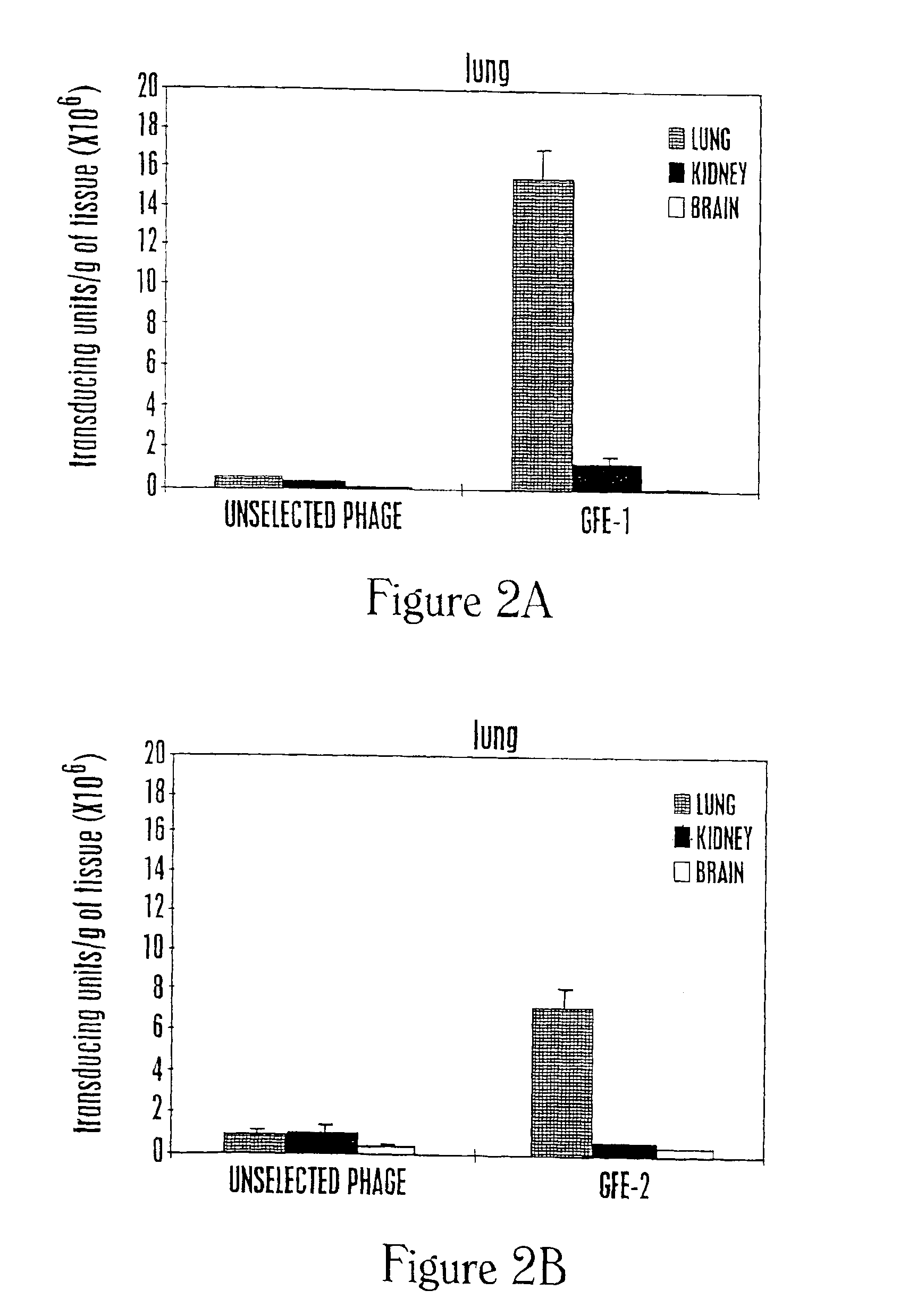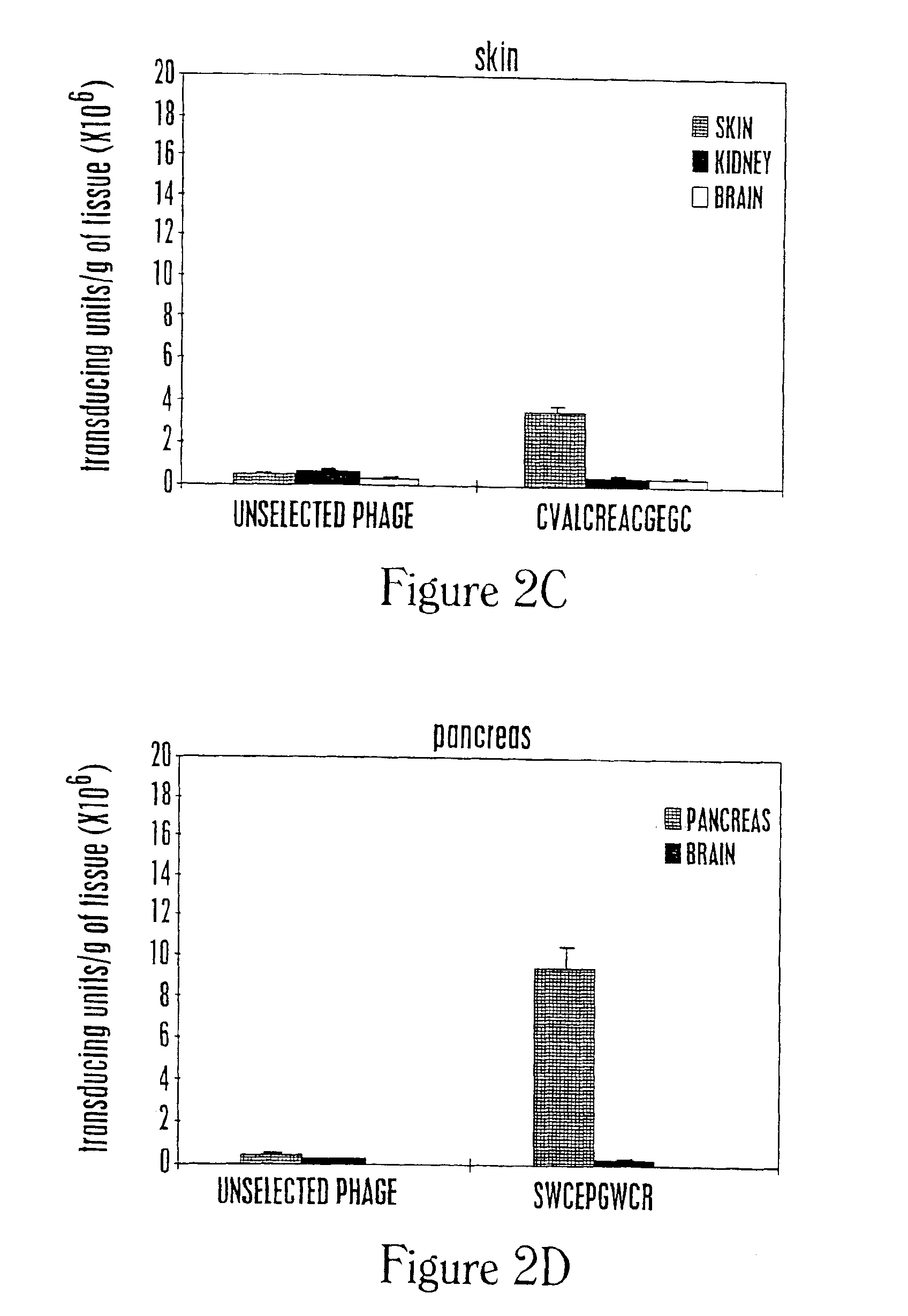Molecules that home to various selected organs or tissues
a technology of molecules and organs, applied in the field of molecular medicine and drug delivery, can solve problems such as unsatisfactory side effects
- Summary
- Abstract
- Description
- Claims
- Application Information
AI Technical Summary
Benefits of technology
Problems solved by technology
Method used
Image
Examples
example i
In Vivo Panning
[0125]This example demonstrates methods for preparing a phage display library and screening the library using in vivo panning to identify phage expressing peptides that home to a selected organ or tissue.
A. Preparation of Phage Libraries:
[0126]Phage display libraries were constructed using the fuse 5 vector as described by Koivunen et al., supra, 1995; see, also, Koivunen et al., supra, 1994b). Libraries encoding peptides designated CX6C (SEQ ID NO: 26), CX7C (SEQ ID NO: 24), CX10C. (SEQ ID NO: 30)) CX3CX3CX3C (SEQ ID NO: 25), X2CX4CX (SEQ ID NO: 23), and X7 (SEQ ID NO: 29), were prepared, where “C” indicates cysteine and “XN” indicates the given number of individually selected amino acids. These libraries can display cyclic peptides when at least two cysteine residues are present in the peptide.
[0127]The libraries containing the defined cysteine residues were generated using oligonucleotides constructed such that “C” was encoded by the codon TGT and “XN” was encoded ...
example ii
Characterization of Peptides that Home to a Selected Organ
[0134]This example demonstrates that an organ or tissue homing peptide of the invention selectively homes to a selected organ or tissue including an organ containing a component of the RES.
A. Lung is the Selected Organ
[0135]After two or three rounds of in vivo panning of mice injected with a cyclic CX3CX3CX3C (SEQ ID NO: 25) or a cyclic CX6C (SEQ ID NO: 26) phage display library, four peptides that homed to lung were identified. The peptide sequences CGFECVRQCPERC (SEQ ID NO: 1; GFE-1) and CGFELETC (SEQ ID NO: 2; GFE-2) appeared repeatedly in the lung and two peptide sequences from the CX6C (SEQ ID NO: 26) library CTLRDRNC (SEQ ID NO: 15) and CIGEVEVC (SEQ ID NO: 16) also were found to home to lung (see Table 2, below).
[0136]To determine the specificity of lung homing of the individual peptides identified, phage displaying the peptides were amplified individually, diluted to the same input titer and administered to mice. Foll...
example iii
Immunohistologic Analysis of Lung, Pancreas and Skin Homing Peptides
[0154]This example demonstrates the localization of lung, pancreas and skin homing molecules using immunohistologic examination.
[0155]Phage displaying homing peptides were detected in lung, pancreas and skin by immunostaining histologic sections obtained 5 min after administration of phage expressing a lung, pancreas or skin homing peptide (“peptide-phage”) to a mouse. Following administration of the peptide-phage, mice were handled as described above and various organs, including lung, pancreas and skin, were removed and fixed in Bouin's solution (Sigma). Histologic sections were prepared and reacted with anti-M13 (phage) antibodies (Pharmacia Biotech; see U.S. Pat. No. 5,622,699, supra, 1997; Pasqualini and Ruoslahti, supra, 1996). Visualization of the bound anti-M13 antibody was performed using a second antibody conjugated to peroxidase (Sigma) according to the manufacturer's instructions.
[0156]Phage displaying t...
PUM
| Property | Measurement | Unit |
|---|---|---|
| diameter | aaaaa | aaaaa |
| morphologies | aaaaa | aaaaa |
| adhesion | aaaaa | aaaaa |
Abstract
Description
Claims
Application Information
 Login to View More
Login to View More - R&D
- Intellectual Property
- Life Sciences
- Materials
- Tech Scout
- Unparalleled Data Quality
- Higher Quality Content
- 60% Fewer Hallucinations
Browse by: Latest US Patents, China's latest patents, Technical Efficacy Thesaurus, Application Domain, Technology Topic, Popular Technical Reports.
© 2025 PatSnap. All rights reserved.Legal|Privacy policy|Modern Slavery Act Transparency Statement|Sitemap|About US| Contact US: help@patsnap.com



